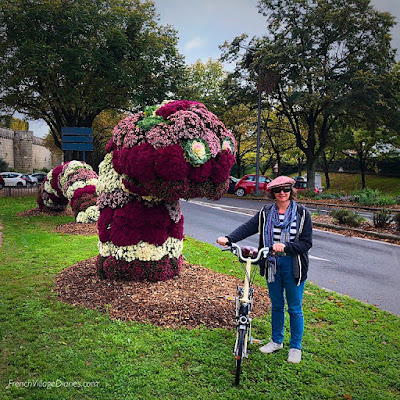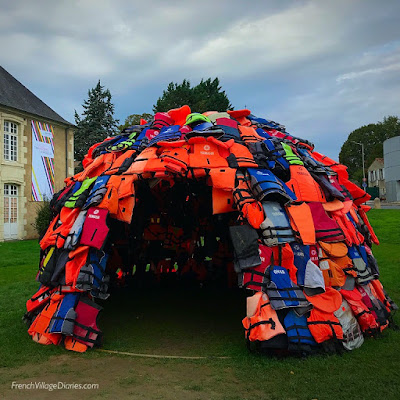 |
| Floral display Parc de Blossac, Poitiers |
Poitiers Insolite (Unusual)
We recently found ourselves in Poitiers with an afternoon to spare. As we had the bikes with us, and for once it wasn’t raining, a bimble to some of our favourite places, with a few new sights too, seemed to be the perfect idea.
 |
| Floral snake, Poitiers |
Our first stop was the Parc de Blossac where the winter floral displays were looking beautiful. With Toussaint (1st November, All Saints Day) approaching, the florists of France are alive with chrysanthemums in the rich colours of autumn. We are not the only Brits in France to have received odd looks from our French neighbours as we’ve decorated our gardens with these beautiful displays - that the French reserve for the cemeteries and gardens of remembrance on All Saints Day. However, the municipal gardeners of Poitiers seem to have followed our lead as not only were the flower beds full of colourful chrysanthemums, but a floral snake sculpture has appeared just outside the Parc de Blossac too.
We then crossed the town centre, where there is currently a multi-location contemporary art exhibition in place, the Traversées \ Kimsooja. In my opinion, it is art, but not as I know it, but some of the pieces certainly got us talking about them!
 |
| Palais du Justice, Poitiers |
One benefit of the exhibition is that the old Palais du Justise (court house) that was once Eleanor of Aquitaine’s residence in the 12th century and has been closed to the public for over 30 years, is now open. The grand hall, (salle des pas perdus – hall of the lost footsteps) with its impressive windows and fireplaces would certainly have been some place for a medieval banquet.
We then joined the river Clain to the north of the town, where quiet roads took us through residential areas.
I was delighted to find hollyhocks still in bloom at the end of October.
We then decided on a mission to find the newly installed signage that marks the finish line for when the Tour de France will arrive in Poitiers on 8th July 2020. Cav, if you are reading this, it will be a slightly uphill sprint finish, on a wide section of the ring road, that I hope will have been resurfaced before you race here. I won’t be camping out just yet, but certainly plan to be there on the day.
With Toussaint so close, we took a detour through the cemetery, where as well as many family mausoleums and chrysanthemums we found a French military cemetery with a Lanterne des Morts as its centrepiece. Les Lanternes des Morts, or Lanterns of the Dead are a peculiar feature, found in only a handful of locations in our area of France. In fact, there are only 36 lanternes left in the whole of France that survived the Revolution (and the subsequent administrative destruction) and 11 of these are in the old region of Poitou-Charentes, with the remainder in the Aquitane. These needles of stone, built between the 11th and 13th centuries, sit near the church or in the cemetery and are a symbol of remembrance to those we have lost. At the top is a cross and an opening and at the bottom, a door where a lamp was placed. The lamp was lit at each death and only extinguished once the burial had taken place. They are always positioned so the opening looks towards the east and the direction of the sun rise, as a symbol of resurrection. I’ve been lucky enough to see a few of those that remain and find them fascinating.
Next to the French cemetery was an area of German military crosses; the final resting place of 104 German soldiers who died as prisoners of war in Poitiers, during the First World War. We were both quite shocked to see so many crosses in a cemetery so far from the Front Line and battlefields.
Our route back towards the cathedral took us past an ancient stone, or Pierre-Levée that has been classified as an historical monument since 1862. This large broken slab supported by three pillars is the remains of an ancient dolmen, a megalithic monument used as a burial chamber.
Right outside Ed’s place is another art installation from the Traversées \ Kimsooja exhibition. This igloo-like frame is covered in life jackets and represents an emergency dwelling where protections at sea are turned into shelters on land. Designed by an architecture student who has helped with humanitarian work in Lesbos, Greece and invented the shelter based on the life vests found on the island’s beaches.
Our short 13km bike tour certainly took in the unusual and with megalithic stones, 12th century palaces and First World War graves, to modern art depicting the current migration crisis, floral displays and a cycle race still eight months away, was probably as varied as it’s possible to get.
The blog has been more than quiet recently, but then as our lives hurtled towards the 31st October Brexit deadline; neither my mood nor heart were in the right place. We now have another reprieve to 31st January 2020, which although drags on the uncertainty we have lived with since June 2016, I would much rather leave with a fully formed plan in place than crash out with no deal.












